When Raffaello Sanzio da Urbino (1483-1520), a Renaissance master better known as “Raphael,” moved to Rome in the early 16th century, he wanted to make a name for himself.
The copious amounts of talent that this Italian artist was blessed with allowed him to achieve that in a manner that only the greatest artists in history could do.
He produced some of his most famous paintings in an important building in Vatican City. These magnificent Renaissance masterpieces have been admired by people from all over the world for over 500 years.
In this article, we’ll take a closer look at some of the most interesting facts about the Disputation of the Holy Sacrament by Raphael.
1. It was painted shortly after Raphael had moved to Rome in 1508
Raphael was born in Urbino, a small city but an artistic hotspot in the Marche region of Italy. This is why his full name refers to “da Urbino.”
His father was a local court painter and the young Raphael was trained by Umbrian master Pietro Perugino after he was orphaned in the 1490s.
He quickly became a master and started traveling around Northern Italy. He lived a Nomadic lifestyle for several years, completing multiple altarpieces in the process.
He spent a significant amount of time in Florence in the early 16th century and made a name for himself in the Tuscan capital.
He finally moved to Rome in 1508 where he spent the rest of his life overloaded with commissions. He completed the Disputation of the Holy Sacrament between 1509 and 1510.
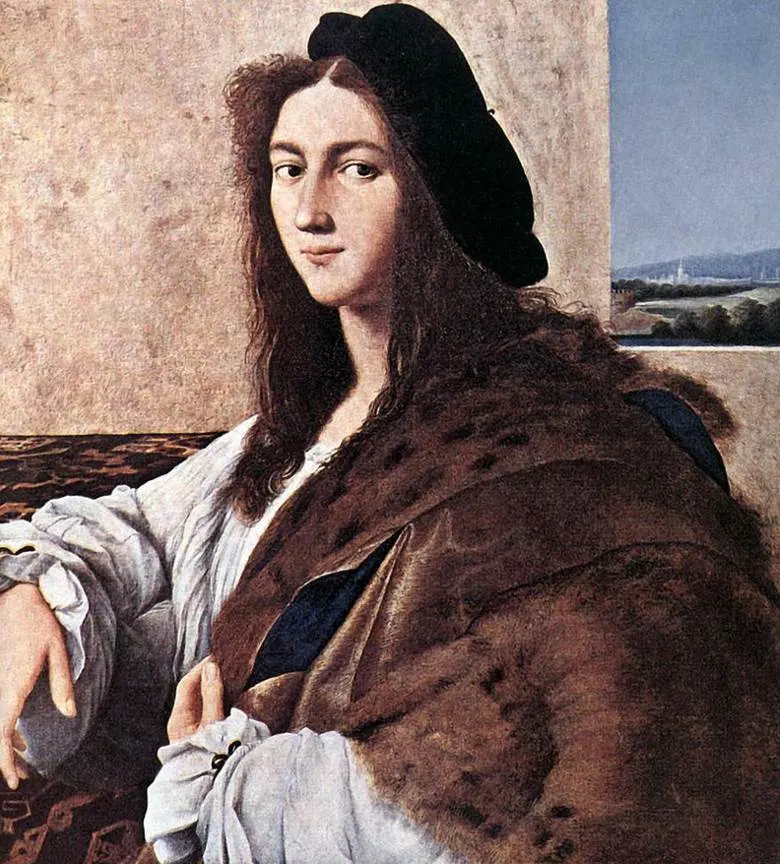
2. It’s located inside a magnificent room of the Apostolic Palace

The word that an incredible young master was conquering Florence spread to the highest levels in Rome.
It was Pope Julius II (1443-1513), a man he painted as well, who had invited Raphael to Rome. The new Pope was a great fan of art and became one of the most famous art patrons in history.
Pope Julius II commissioned the painting of the “Stanza della Segnatura,” one of the rooms inside the Apostolic Palace in Vatican City.
This was quite a prestigious commission because this palace serves as the official residence of the Pope, the head of the Catholic Church.
Today, the 4 rooms that Raphael eventually completed (although the 4th was probably completed by his workshop following his early death in 1520) are known as the “Stanze di Raffaello” or “Raphael Rooms.”
These are some of the most famous paintings at the Vatican and are part of the tour of the Vatican Museums.
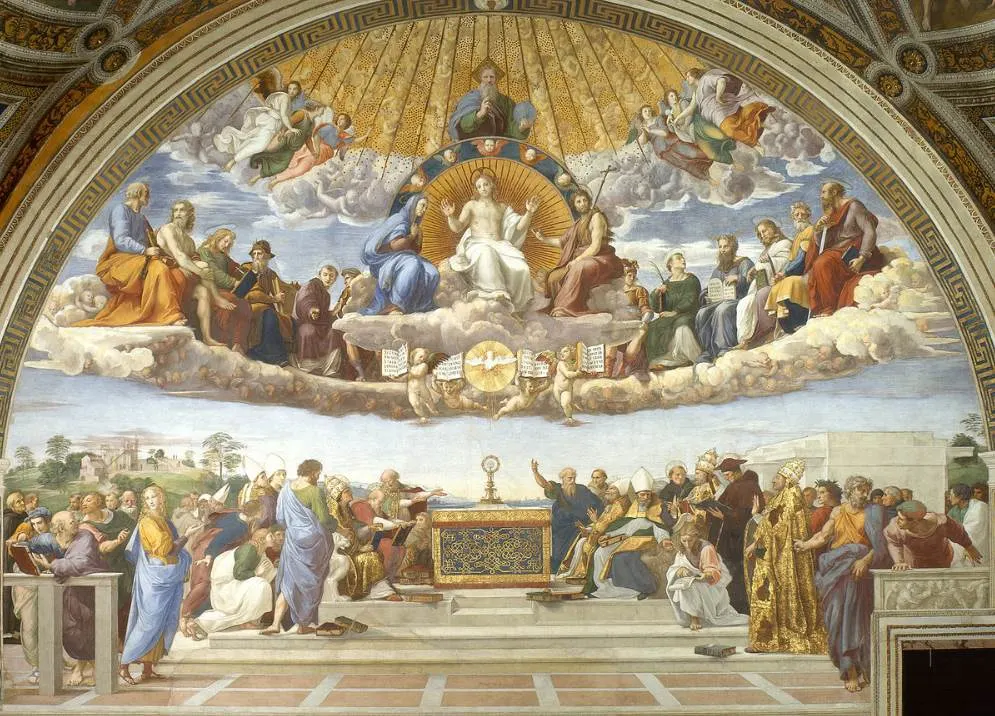
3. The painting is accompanied by three other masterpieces by Raphael
The Stanza della Segnatura was the first room to be completed by Raphael. It’s fair to conclude that this achievement instantly sent shockwaves through the art community in Rome.
The result was the commission for 4 additional rooms. and countless other commissions during the 12 years that he resided in the city.
This particular room served as the Pope’s library at the time and features some of the artist’s most famous masterpieces. These were based on the subjects of theology, philosophy, jurisprudence, and the poetic arts.
The other paintings on the walls of the Stanze della Segantura are:
- The Parnassus
- The School of Athens
- The Cardinal Theological Virtues
One of the most remarkable facts about The Disutpation of the Holy Sacrament is that it was the first fresco to be completed inside the room.
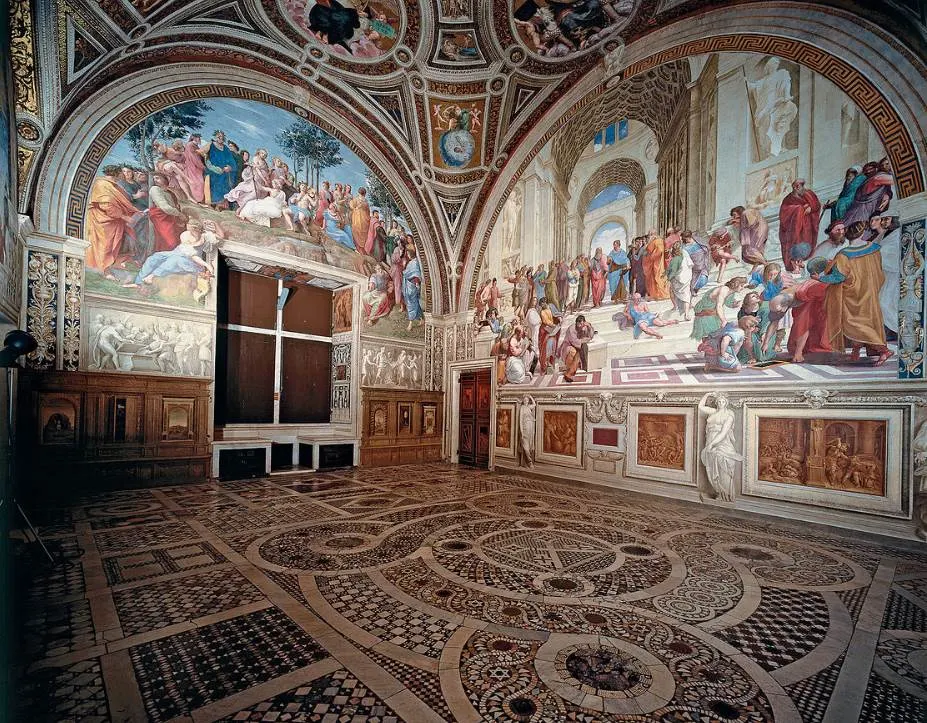
4. The painting features both a heavenly and an earthly part
The Disputation of the Holy Sacrament is a representation of the Catholic Church. That’s why Raphael split the composition into two halves as it spans both heaven and earth.
The heavenly part above perfectly intertwines with the earthly part below. This clearly shows the influence of Florentine artists on Raphael.
5. The heavenly part features numerous Biblical features and religious symbols
The upper part of the painting is dominated by the central figure of Jesus Christ who is surrounded by a large aureole.
Just above him, we can see God the Father who is adored by angels and engulfed in gold light.
Raphael integrated an arrangement known as the Deësis because the Virgin Mary and John the Baptists are sitting right next to Jesus.
Other Biblical figures who can e identified are:
- Peter – The man on the far left who is holding a set of keys.
- Adam – The half-naked man sitting right next to Peter.
- Paul – The man on the far right who is holding a book and a sword.
- Moses – The man on the right who is holding the Ten Commandments.

6. Raphael included the 4 original doctors of the Catholic church
The lower part of the painting is centered around the altar on which the monstrance stands. This is used for the Transubstantiation or the turning of bread and wine into the Body and Blood of Jesus Christ.
On both sides of this altar, we can see people debating the Eucharist, all of them who have significant importance in the Roman Catholic church.
Some of the people who have been identified are:
- The original four Doctors of the Church – Pope Gregory I, Jerome, Augustine, and Ambrose.
- The current and former popes at the time – Pope Julius II and Pope Sixtus IV.
- Girolamo Savonarola (1452-1498) – A preacher who was active in Renaissance Florence.
- Dante Alighieri (1265-1321) – An Italian poet, writer, and philosopher.
- St. Thomas Aquinas (1225-1274) – An influential priest, theologian, and philosopher.
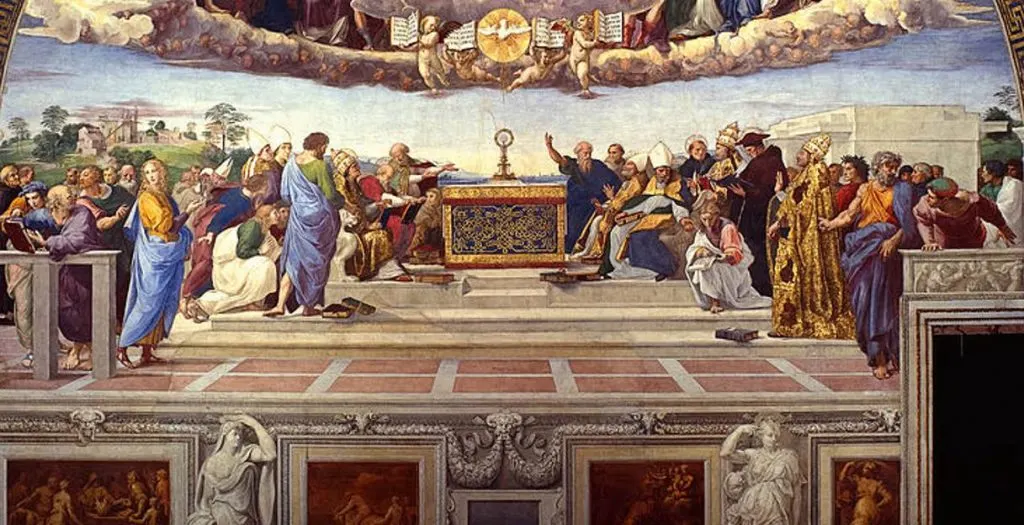
7. How big is the Disputation of the Holy Sacrament by Raphael?
Just like every other fresco inside the Raphael Rooms, this painting is immense. That’s because it covers the entire wall of the Stanze della Segantura.
The Disputation of the Holy Sacrament by Raphael has dimensions of 500 × 770 centimeters (196 × 303 inches).
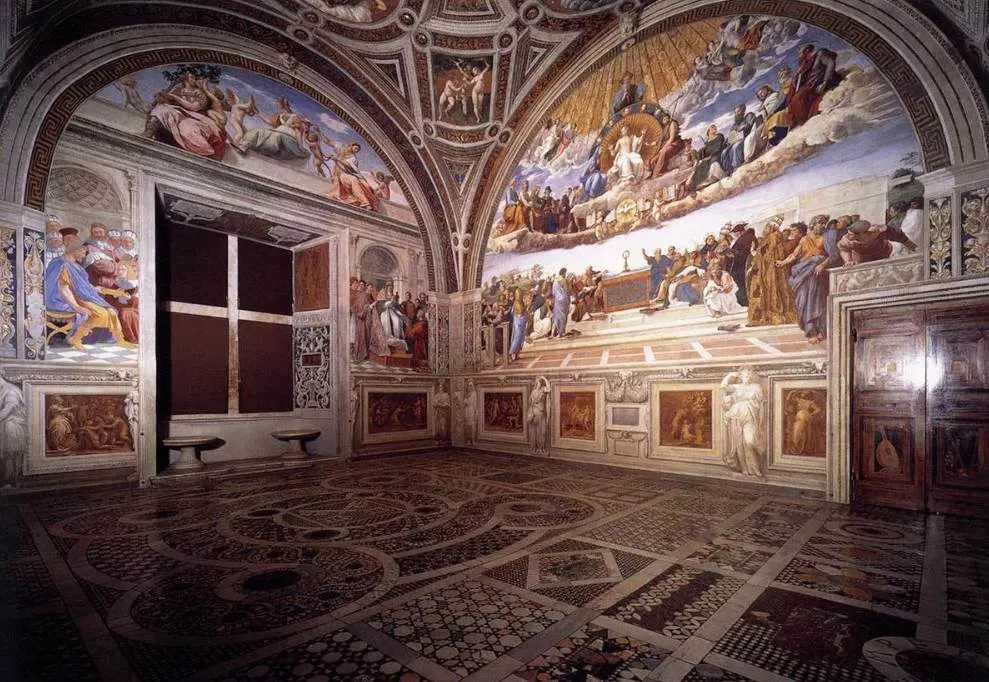
8. Did Raphael include the original architect of St. Peter’s Basilica?
Raphael was possibly invited to Rome by Donato Bramante (1444-1514), the original architect of St. Peter”s Basilica.
He already added Michelangelo and Leonardo da Vinci to The School of Athens (along with his self-portrait). He likely included Bramante in this work as well.
The man reading a book while leaning over the railing in the bottom left corner is probably the old master he came across during one of his previous adventures.

